|
(Part 2)
Some Thoughts on the Water Crystal Experiments
(Accompanying photographs are courtesy of
Dr. Masuru Emoto’s
books
Messages from Water and More
Messages from Water, published by Hado
Publishing)
The water crystal experiments carried out by
Dr. Masaru Emoto in Japan were published in newspapers and have produced enthusiastic
response among readers. We subsequently interviewed several people in
scientific circles and invited them to talk about the significance of the
experiments. Below is an interview with physicist Dr. Cheng Luojia.
Zhengjian Reporter: In your opinion, what is the most unique thing about the
water crystal experiments carried out by Mr. Emoto?
Dr. Cheng Luojia:
The experiment is pretty simple. It demonstrates the
differing ways of water crystallization in different situations. It is rare
to have an experiment that is this concise, intuitive, and easy to
understand, and that in itself is a huge accomplishment. This experiment
deals with an extremely immense and important subject, namely how people’s
minds influence matter. Not too many experiments have been done in this
area. The relationship between matter and mind is a topic that has been
debated for a long time. Being able to explore the relationship between the
two using such a simple experiment is very meaningful.
In addition, the original photographs of the experiments are enlarged 200 to
500 times. The observations have actually reached microscopic levels, that
is, it is observing microscopic planes instead of points. This is rarely
seen in scientific circles. I believe observation of the whole microscopic
plane will bring forth a brand new world to us.
I think, both in terms of its subject and its research methodology, this
experiment is a new beginning in science.
Reporter: The results of the water crystal experiment have been published in
detail in the two-volume book Messages from Water. Which parts have
impressed you most?

Dr. Cheng: The first picture in the book is an ice image, water in the
frozen stage, about to melt into water, but has not yet become water. It
represents a complete drawing of the Chinese character for water! The
ancient ancestors of the Chinese people perhaps already had the capability
to see to the microscopic level. This (above) picture gives me a new understanding
of Chinese pictographic writing.
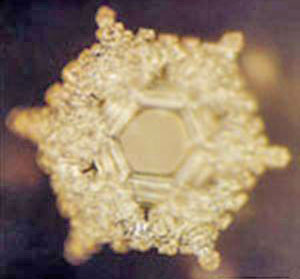 
Picture on the left: Taken after the container of water had been exposed to
the written words “Love” and “thank you.”
Picture on the right: Taken after the container of water had been exposed to
the written words “You are really nauseating and disgusting. I’ll kill you!”
When the words “Love” and “thank you” are spoken to the water sample, the
water crystals form a beautiful pattern. When the water sample was exposed
to harsh, destructive words, the crystal formed is in chaos and without
order. The contrasting results are amazing and are a direct reflection of
the influence of people’s mind on matter. We used to think that people’s
mind intent and spirit were metaphysical. They belong to a different
category from matter, but this experiment has revealed an in-depth
relationship between matter and mind.
Furthermore, we are also able to see that good intent positively influences
matter, and bad thought patterns make matter ugly. When you speak
“beautiful” to the water, its crystal becomes beautiful. When you speak
“dirty” to it, its crystal really looks extremely dirty. Looking at these
pictures, a mother would probably understand that more encouragement and
praise would make children become more intelligent and beautiful. A
harmonious family atmosphere would also contribute to healthy looking plants
in the house and help keep them beautiful. The enlightenment the public
might gain from this experiment should not be underestimated.
Reporter:
This experiment has also tested how language, image and sound
affect water. What is your view about the results?
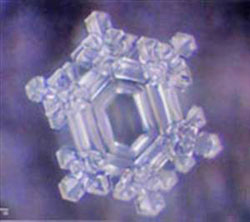 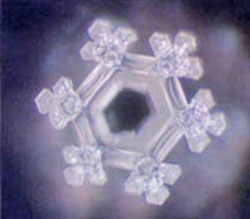 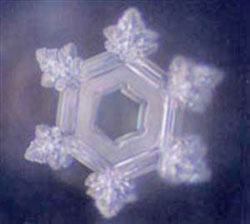
“Wisdom” in Japanese “Wisdom” in English “Wisdom” in German
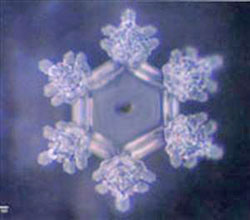 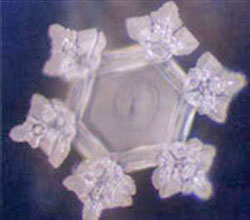 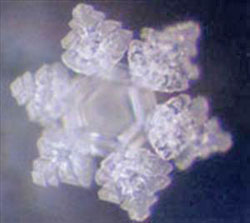
“Cosmos” in Japanese “Cosmos” in English “Cosmos” in Greek
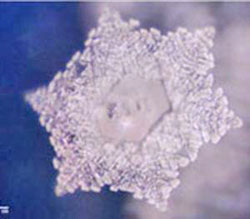 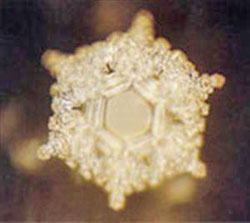 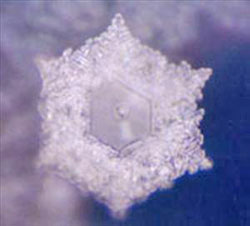
“Love, thanks” in Japanese “Love, thanks” in English “Love, thanks” in
German
Dr. Cheng: It is very interesting. Exposed to the word “Wisdom,” written in
Japanese, English and German, the water formed a similarly shaped crystal.
Exposed to the word “Cosmos,” written in Japanese, English and Greek, the
water did the same, too, and likewise to “Love” and “Thanks.” This indicates
that it is not the individual word, the language in which it spoken or the
sound vibrations that are the reason for the formation, but the inherent
thought processes behind the language or meaning represented by the language
that influences the water. The same meaning or the same information will
produce the same effect, even though it is expressed in different languages.
In this case of water, if we advance our thought a step further, that every
word/thought produces a different shape, what conclusion can we draw? We can
arrive at only one logical conclusion - the meaning of a word produces a
shape! In other words, thoughts have shapes! Doesn’t that say mind is
matter?
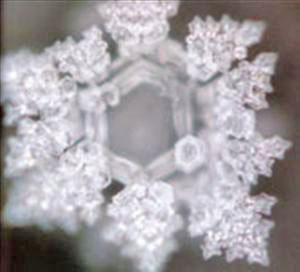
Water crystal after “reading” a Lotus picture
Water is also very sensitive to images. After “reading” a lotus picture, a
water crystal will grow unceasingly, as a lotus grows unceasingly. After
“reading” a picture of a fir tree, the water will periodically change its
color in the process of crystallization, as a tree undergoes changes, like
its respiration process. More interesting yet is when water “reads”
a
picture of the sun or the word “sun,” the two crystals formed are identical
in shape. This indicates that an image also possesses a kind of
consciousness, a kind of information. The same as a word, it represents a
kind of thought, but is expressed in a different way. Every kind of shape
represents a kind of spirit. An ancient adage tells us that similarity of
shape is similarity of spirit. This is one reason why a painting can express
the artist’s thought and emotion and evoke those in the viewer.
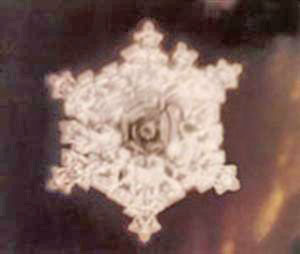
Beethoven’s music “Pastoral”
The capability of water of listening to music is more impressive. After
water “listens” to a musical composition by
Bach, the shape of a water
crystal looks neatly organized and clear. The shape of a water crystal looks
clear and jubilant after the water “listens” to Beethoven’s “Pastoral”
symphony. After “listening” to a nursery rhyme, water will become clear and
pure. After listening to a musical composition entitled “Forest in the dim
light of night,” the water crystal appears to be shrouded in the dim light
of night. The dimness reflected in the crystal is not due to lack of light,
but sound. Those results have shown that the sound and the shape of an
object are interconnected. This really opens up a totally new world.
The interconnecting relationship between the sound and the
shape is an
important new concept. For example, a good musical instrument must have a
good shape. In ancient times, when casting a bell, an experienced worker
would be able to know if the sound of bell was good or not with just a
glance at the shape of the bell when it was taken out of the furnace mold.
The influence of sound on shape manifested in this experiment is very vivid.
Reporter: Most people are initially surprised when they see those marvelous
and beautiful water crystals. They did not expect water to have so many
connotations.
Dr. Cheng: Actually, in Chinese tradition, people had a meticulous
understanding of water. For example, in creating medicine one must chose
water carefully. To make Aijiao (a Chinese traditional medicine), water from
a well called Ai in a village called Ai in
Shandong Province must be used.
Water for boiling tea was also carefully chosen. Some tea must be made with
specific spring water, some must be made with dew from lotus leaves, other
tea was prepared with snow from plum blossoms; another tea was yet prepared
with the water from a certain segment of a certain river. All of these do
not only prove that people in ancient China were refined and cultured; they
also represented in-depth knowledge of the nature of water.
I once heard a
story: In the countryside of China, women know a lot of simple but effective
folk remedies. Among them, water is one of the most commonly used. For
instance, when a child eats something not too well cooked, he or she will
get a stomachache. Sometime the pain is so violent that the child rolls
about on the ground. His mother will then heat a bowl of water to the point
where it is just about to boil but not quite boiling yet. When the child is
fed the water, the pain will be gone immediately, an instantaneous effect.
Water usage among the people for different uses is numerous. An
understanding of water is part of Chinese tradition from ancient times.
Reporter: In the postscript of the book
The Message from Water, the author
raised several questions - where it comes from, where it goes, what is the
purpose of existence, and others. How do you respond?
Dr. Cheng:
Instead of only focusing at the subject at hand, Dr. Emoto is
able to jump out of the box and take on profound questions. It is an
indication of his open-mindedness. Water is an essential factor in the
creation of everything. To understand water also helps us to
understand
matter, spirit and life.
References:
-
Masaru Emoto, “Messages from Water,” by Hado (Kyioku Sha) Publishing, Japan,
2000.
(http://www.hado.com)
-
Masuru Emoto, More Messages from Water, an interview with Dr. Emoto,
published in
The Spirit of Ma’at, Volume 1, November 2000;
http://www.spiritofmaat.com/archive/nov1/cwater.htm
-
Messages from Water, The Messenger, Report by Joann Turner, February 2002,
Pasadena, CA;
www.themessenger.info/Feb2002/MessfromWater.html
Translated from:
http://zhengjian.org/zj/articles/2002/12/27/19793.html
Go Back
|













